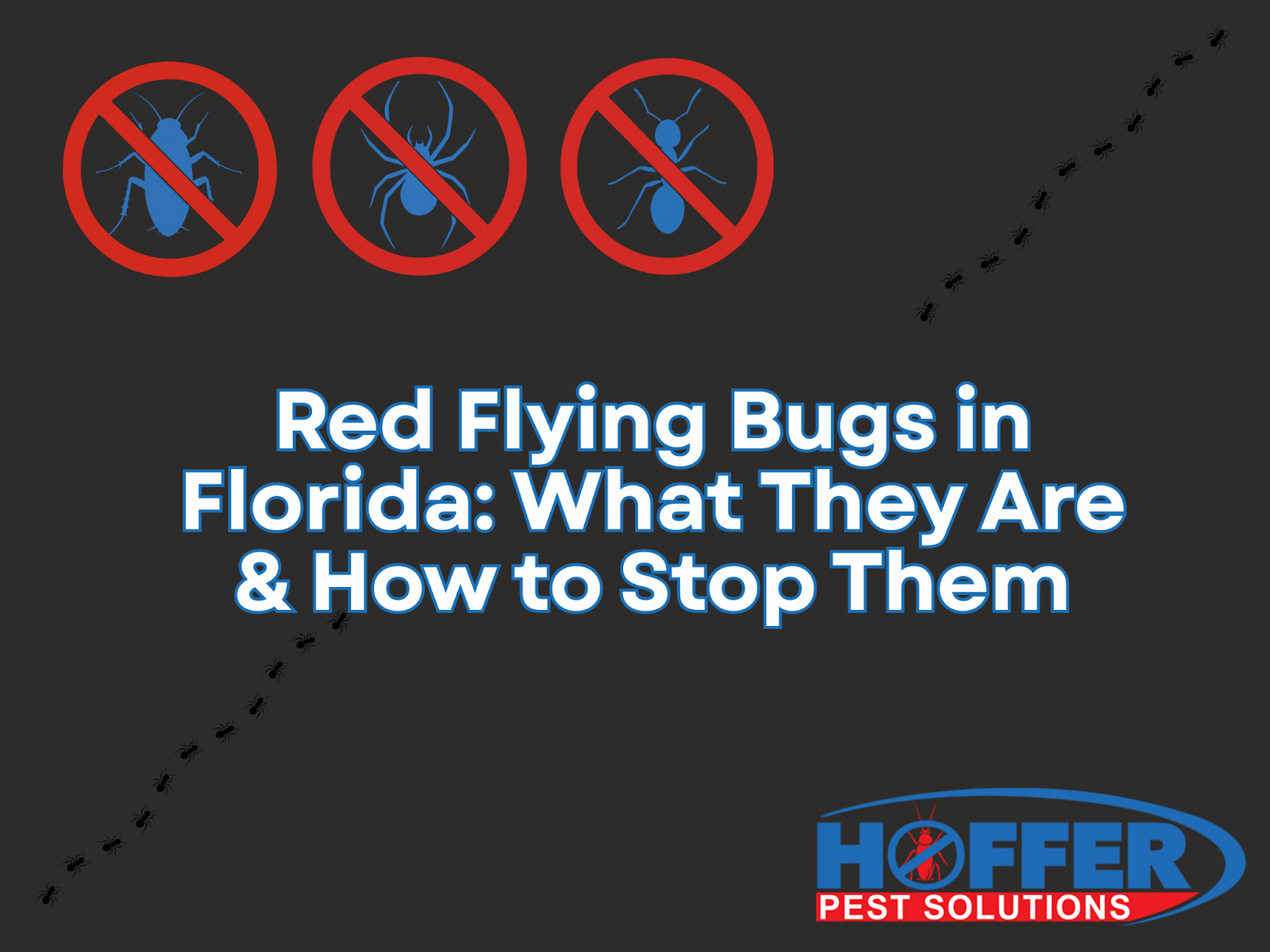Most red flying bugs in Florida are jadera bugs, lovebugs, or oleander moths. While harmless, they swarm near trees, stain walls and clothes, or damage car paint. Identifying these pests helps protect homes and lawns while keeping Florida properties bug-free year-round.
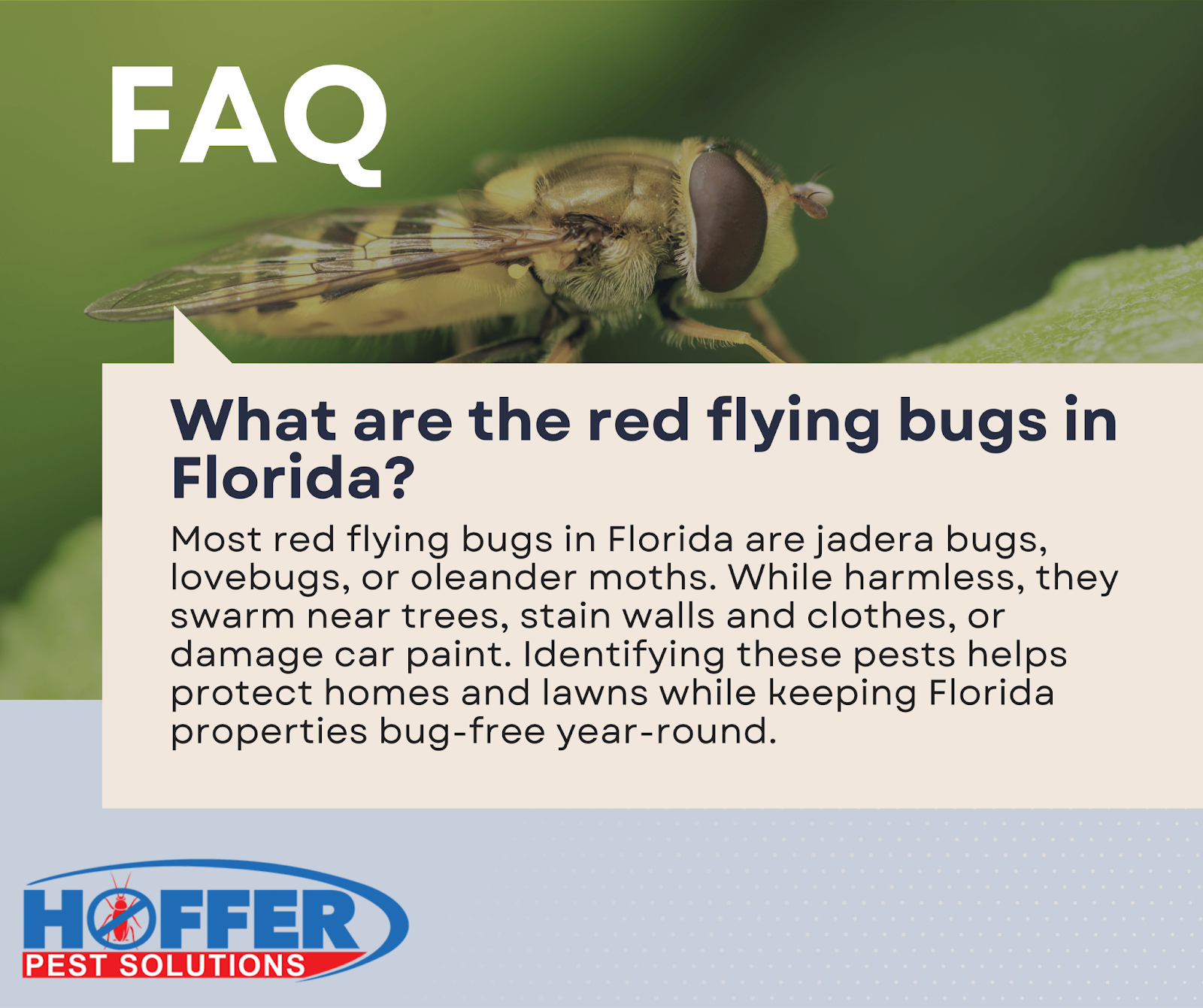
Florida’s climate creates the perfect environment for insects to thrive year-round, and not every red flying bug is what it first appears. Some, like jadera bugs, cluster in the hundreds near golden rain trees. Others, like lovebugs, splatter cars during their short but frustrating mating season. Then there are oleander moths, which look like wasps but are harmless pollinators. The challenge for homeowners is knowing which insects are simply a nuisance and which require action.
Hoffer Pest Solutions spent nearly 50 years helping Florida families deal with the unique pest pressures of this region. Whether it’s a staining swarm on your patio, caterpillars stripping your landscaping, or stinging velvet ants around your yard, our team knows how to respond quickly, safely, and effectively.
If you want the full breakdown of Florida’s most common red flying bugs, and the steps you can take to prevent them, keep reading.
The Jadera Bug: Florida’s Most Common Red Flying Bug

The most frequent culprit behind “mystery red bugs” in Florida yards is the jadera bug, also called the red-shouldered bug or golden rain tree bug. Adults are black with striking red edges along their wings and abdomen, while nymphs are bright red with black legs. Homeowners often confuse them with boxelder bugs, but unlike their lookalike relatives, jadera bugs don’t give off foul odors when disturbed.
Jadera bugs thrive where golden rain trees drop seeds. They gather in large colonies around lawns, mulch beds, or under shrubs, especially in spring. As temperatures rise, they often appear in massive numbers. When crushed, they release a deep red pigment that stains clothing, patios, siding, and even playground equipment, turning what should be a minor annoyance into a messy problem.
Despite the swarms, jadera bugs do not bite or sting, and they aren’t a health hazard for people or pets. Their primary food is fallen seeds and sap, though large populations can stress plants. Simple prevention, raking and disposing of seeds, can greatly reduce their numbers without chemicals.
Lovebugs: The Red-Thoraxed Highway Swarm
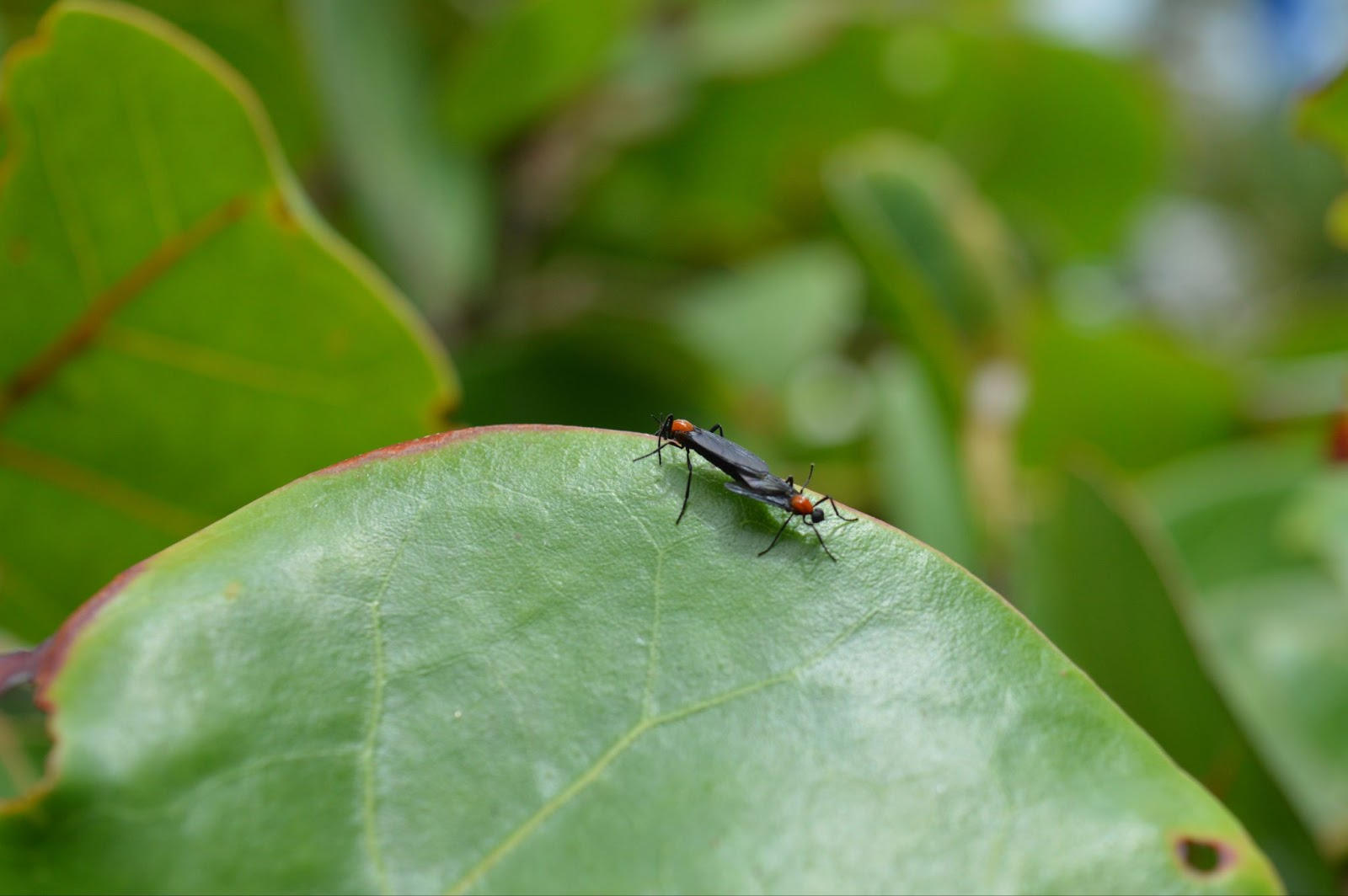
Another familiar red-and-black insect in Florida is the lovebug, which shows up twice a year in huge swarms along highways, parking lots, and yards. These small black flies have a bright red thorax and are most often seen stuck together in pairs during mating season. Their main nuisance is the acidic residue they leave behind on cars.
Anyone who has driven through Florida in late spring or late summer has likely dealt with the mess. Left unwashed, the splattered bodies quickly corrode car paint and clog radiators. Because of this, many residents dread “lovebug season”.
The best defense is preparation: wax your car before peak season, clean windshields promptly, and wash vehicles as soon as possible after long drives. While harmless to humans and pets, their presence is one of Florida’s most frustrating natural events.
Helpful resource -> Love Bugs in Florida: What They Are & How to Deal with Them
The Velvet Ant (Cow Killer): Florida’s Painful Myth
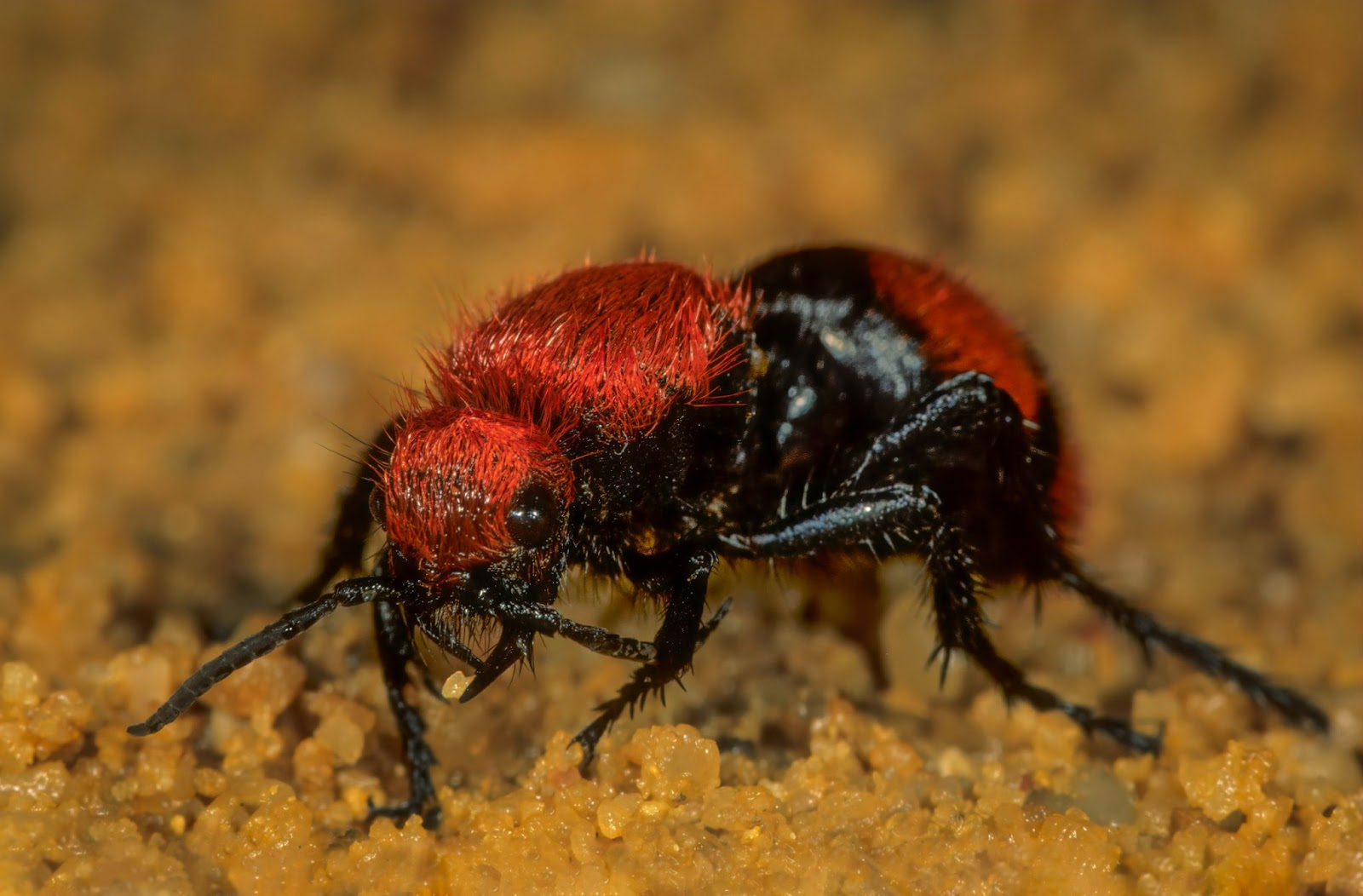
Few insects spark as much fear as the velvet ant, commonly called the “cow killer.” This bright red and black insect is a type of wasp. Its fuzzy body and slow crawl make it noticeable in yards and sandy soils across Florida.
The myth that velvet ants can kill cows has circulated for generations, but it isn’t true. What they do possess is one of the most painful stings in the insect world. While not life-threatening, it’s enough to make anyone cautious. Pets, especially curious dogs, are at risk if they sniff or try to mouth one.
Unlike jadera bugs or lovebugs, velvet ants are solitary and don’t swarm. They’re not aggressive, but handling one almost guarantees a sting. If you spot them repeatedly in your yard, the safest move is not to squash them but to call a professional for safe removal.
Helpful Resource -> Are Red Velvet Ants Dangerous?
Other “Red Bug” Confusions in Florida
Not every “red flying bug” is a jadera, lovebug, or moth. Florida’s insect diversity leads to frequent misidentifications:
Eastern Lubber Grasshopper
Large, colorful, and slow-moving, these insects often frighten homeowners who think they’re a new invasive “red bug.” While they can’t fly far, they do damage gardens and landscaping.
Mosquitoes
Their itchy red welts cause some to confuse them with biting red bugs. In Florida, they’re a far more serious concern, spreading diseases like Zika, dengue, and West Nile virus.
Palmetto Bugs (cockroaches)
At night, their reddish-brown bodies can appear to be “red flying bugs” when light reflects off their wings.
With so many species sharing overlapping colors, it’s no wonder Florida homeowners often fear the worst when spotting something red in motion.
Prevention & Control Tips
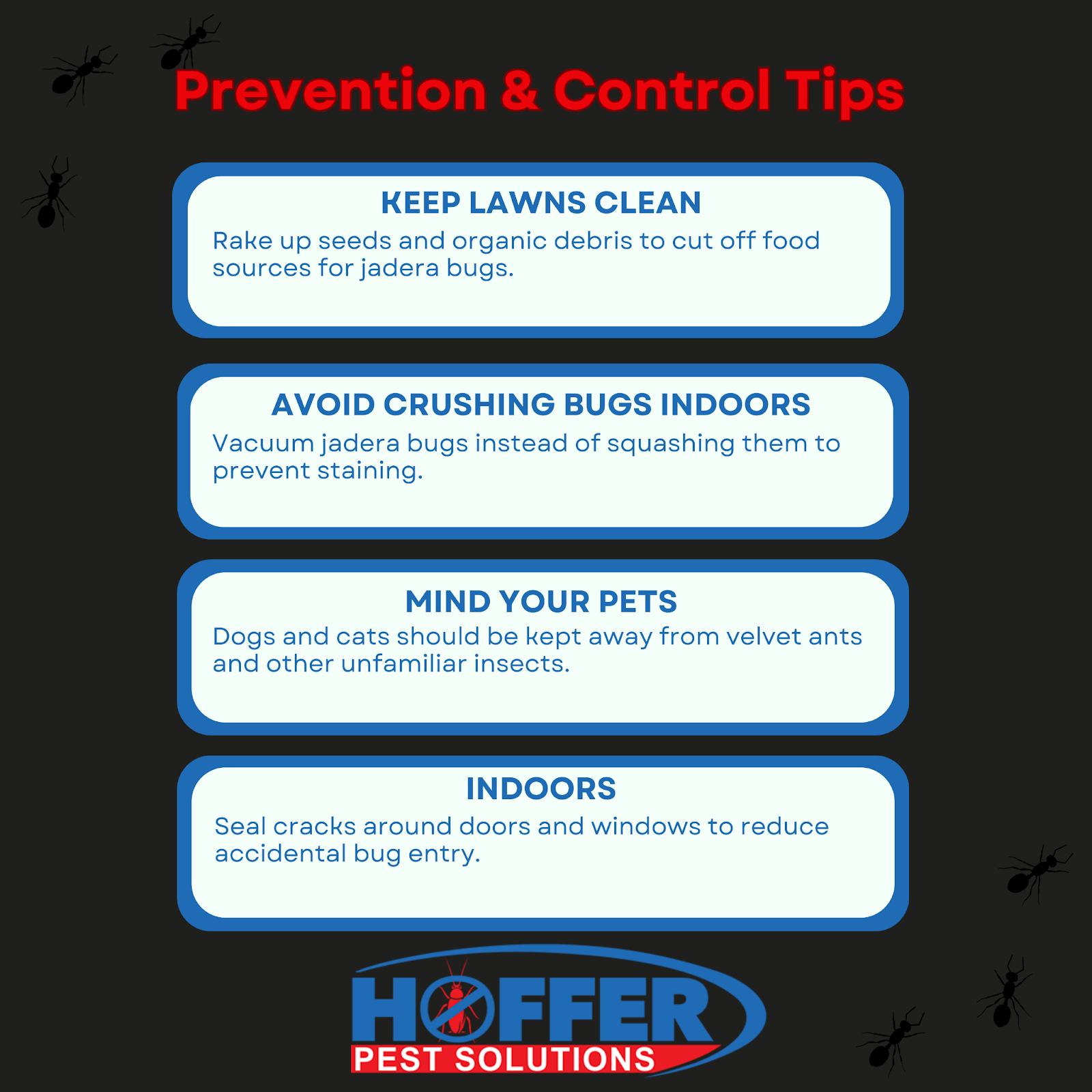
Even harmless bugs can feel overwhelming when they appear in large numbers. Prevention starts with simple habits:
- Keep lawns clean: Rake up seeds and organic debris to cut off food sources for jadera bugs.
- Avoid crushing bugs indoors: Vacuum jadera bugs instead of squashing them to prevent staining.
- Mind your pets: Dogs and cats should be kept away from velvet ants and other unfamiliar insects.
- Indoors: Seal cracks around doors and windows to reduce accidental bug entry.
These steps reduce nuisance infestations while keeping your property free of stains, plant damage, and pest-related stress.
When to Call a Professional
A swarm of jadera bugs on your patio, a cluster of oleander caterpillars devouring shrubs, or repeated velvet ant sightings can quickly overwhelm DIY efforts.
You should consider calling a professional when:
- Jadera bug colonies number in the hundreds or begin staining siding, patios, or clothes.
- Lovebug swarms are so heavy they disrupt daily activity or property maintenance.
- Velvet ants appear repeatedly in areas where children or pets play.
- Oleander plants are stripped bare by caterpillars.
We’ve seen firsthand how frustrating these infestations can be. As a family-owned company serving South Florida for nearly 50 years, we provide eco-friendly, same-day service designed to handle everything from nuisance swarms to dangerous stinging pests. Get in touch with us for a quick inspection.
Why Choose Hoffer Pest Solutions

Dealing with bugs in Florida is a year-round reality, but it doesn’t have to be a constant worry. Hoffer Pest Solutions offer:
- Family-Owned Expertise: Serving South Florida since 1975, we know the unique pest challenges of this climate.
- Fast Response: Same-day service is available if you call before noon.
- Eco-Friendly Treatments: We prioritize environmentally responsible solutions that are safe for families and pets.
- Trusted Results: With over 1,000 five-star reviews and a 4.9 rating, Florida homeowners continue to count on us for lasting relief.
- Comprehensive Protection: Our pest control plans cover over 20 of the most common household pests, including seasonal nuisances like red flying bugs.
If you’re tired of battling swarms in your yard or worried about painful stings, let our team help.
Your Next Step Toward a Bug-Free Home
Florida is full of colorful insects that spark both fascination and fear. While many of the “red flying bugs” you encounter are harmless, their presence can still disrupt daily life, damage plants, stain surfaces, or create worries for children and pets.
We believe your home should be your sanctuary. Protecting your family, your property, and your peace of mind is what we do best. When red bugs invade your space, we’ll be there with reliable, local expertise to make sure they don’t stay for long.
See red flying bugs around your home? Contact Hoffer Pest Solutions today for fast, dependable help.
FAQ
Why do these bugs swarm around my house?
Most red flying insects, especially jadera bugs, are drawn to food sources like fallen seeds from golden rain trees or to areas with moisture and light. Eliminating seed debris and trimming vegetation reduces the attraction.
Are red bugs dangerous to pets?
For the most part, no. Jadera bugs, lovebugs, and oleander moths are harmless to people and pets. The exception is the velvet ant, which delivers a painful sting if disturbed. Curious dogs are most at risk, so keeping pets away is mandatory.
Do I need to remove golden rain trees to stop infestations?
Not always. While these trees are a primary food source for jadera bugs, careful raking and seed removal often control populations without cutting down mature trees.
Are these bugs seasonal or year-round?
Florida’s warm climate allows many pests to persist year-round. Jadera bug populations typically peak in spring and summer. Lovebugs appear twice a year during mating seasons, while oleander moths and caterpillars emerge seasonally depending on plant growth.
How can I safely move velvet ants without killing them?
Velvet ants should never be handled directly. The best approach is to gently trap one in a jar and relocate it away from your yard, or rely on a pest control professional to handle them safely.


